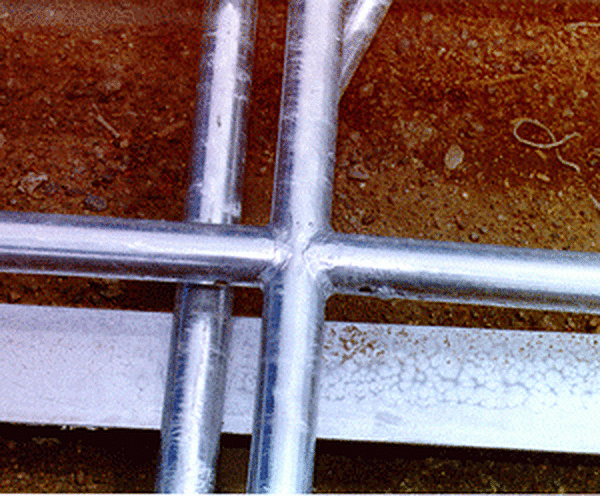Welding Before HDG

Unless a welded structure is too large for the galvanizing kettle, best practice is to weld prior to galvanizing to ensure the entire structure is coated with corrosion-inhibiting zinc. Throughout North America, variously sized hot-dip galvanizing kettles are available, allowing a broad scope of structural fabrications to be galvanized. However, as with any fabrication to be galvanized, it is important for the steel's surface to be entirely clean for zinc to react with the steel.
When welded items are galvanized, the cleanliness of the weld area and the metallic composition of the weld itself influence the galvanized coating's characteristics. Galvanized materials may be easily and satisfactorily welded by all common welding techniques. The specific techniques can best be obtained from the American Welding Society or your welding equipment supplier. Additional information about welding galvanized steel may be obtained from the AGA.
Several welding processes and techniques have been found to be successful for items to be galvanized:
- In welding, an uncoated electrode should be used when possible to prevent flux deposits on the steel or product.
- Welding flux residues are chemically inert in the pickling solutions commonly used by galvanizers; therefore, their existence will produce rough surfaces and coating voids. If a coated electrode is used, all welding flux residues must be removed by wire brushing, chipping, grinding, pneumatic needle gun, or abrasive blast cleaning.
- Welding processes such as metal inert gas (MIG), tungsten inert gas (TIG), or carbon dioxide (CO2) shielded are recommended since they essentially produce no slag. However, there can still be small flux-like residues that need to be chipped off.
- In the case of heavy weldments, a submerged arc method is recommended.
- If none of these welding methods is available, select a coated rod specifically designed for self-slagging, as recommended by welding equipment suppliers.
- Choose a welding rod providing a deposited weld composition as close as possible to the parent metal. The composition and compatibility will yield a more uniform galvanized coating appearance. A list of welding electrodes which promote a more uniform appearance are provided in Table 1.
TABLE 1: RECOMMENDED WELDING MATERIALS FOR WELDING BEFORE HDG (UPDATED 2017)
| Welding Process | Lincoln Electric Welding Electrode | AWS Designation | Silicon (Weight %) |
|---|---|---|---|
| SMAW | Jetweld 2 Fleetwood 35 LS | E6027 E6011 | 0.22-0.26% 0.10-0.18% |
| SAW | L60-860 | F6A2-EL12 | 0.24% |
| FCAW | *NR-203 NiC+ NR 203 MP NR 233 NR 311 | E71T8-K2 E71T-8J E71T-8 E70T-7 | 0.06% 0.22-0.26% 0.19-0.20% 0.12-013% |
Welding Appearance
When welded items are galvanized, two factors affect the galvanized coating's quality and appearance - cleanliness of the weld area and metallic composition of the weld itself. Welding rods high in silicon, which acts as a catalyst for coating growth during the galvanizing process, may cause excessively thick and/or darkened galvanized coatings to form over the weld. In smooth products welded together with high silicon weld rods, the coating over the weld material will be thicker than the surrounding coating, causing a bump in an otherwise smooth product. This appearance sometimes referred to a "raised weld" or "swollen weld" and may require smoothing after galvanizing depending on the intended use of the product. Therefore, the composition of the weld electrode is important, and should be as similar as possible to the steel chemistry to minimize differences in appearance. The composition compatibility will yield a more uniform zinc surface appearance and thickness. As with galvanizing high silicon steel, welding rods high in silicon may cause excessively thick and/or darkened galvanized coatings to form over the weld.
